Carb Spacers, Whats the low down on them?
#1
So I have a healthy 509 built by Jim Velako. It dynod at 684hp. I am thinking about adding a carb spacer as I have heard HP500 style motors respond well to them. Although my motor is more radical than most HP500s, I am still wondering if there is any advantage adding a spacer. Since it has already been dynoed am I wasting my time guessing at this?
Motor has Velako Messaged Dart Pro1 heads, 1000cfm carb, Dart intake, and large bump stick (which I do not know the specs on).
If so, how big, what material and what style. I know some are open and some are 4 hole? Where will the gains be?
Motor has Velako Messaged Dart Pro1 heads, 1000cfm carb, Dart intake, and large bump stick (which I do not know the specs on).
If so, how big, what material and what style. I know some are open and some are 4 hole? Where will the gains be?
#3
Registered
What he said...........generally speaking I think the spacer will bring the power down in the RPM range a bit. That could be a factor depending what RPM the motor made the 684 on the dyno as opposed to what RPM you ultimately see in the boat.
#4
Registered
iTrader: (4)
If anything try a phenolic 4 hole. Remember those runners are welded up for optimal flow at minimal port size. If you kept the solid cam in it, it is close to my old 252/264, .630/630 Ultradyne.
I don't think Travis could close the hatch with a spacer.
I don't think Travis could close the hatch with a spacer.
#7
Registered
iTrader: (1)
I wrote this for another website forum years ago. It's long, but helpful. Enjoy.
Benefits:
Carburetor spacers can help many engine combinations pick up solid power increases from more airflow into each cylinder. Airflow not always being everything, spacers can create a stronger and more accurate air stream coming thru the carburetor, which in essence, gives you better carburetion and thus more power also. Other benefits can include better throttle response, tighter cylinder to cylinder exhaust temperature differences, and more consistent carburetion.
================================================== ======
Materials :
Cast aluminum, plate aluminum - ie: billet, plastics - few different types, and phenolic. Phenolic looks like 'wood' and thus is commonly referred to as either 'phenolic' or 'wood' or 'phenolic wood.' It is actually a resin and laminate combination.
What material is better ?
For marine performance engines I like to use either billet aluminum and/or phenolic.
Billet aluminum is by far the strongest carb spacer material available. It will not crack, warp, or melt with any engine temperature. You could probably kick it down your asphalt driveway , by mistake of course, with it still being okay other than a few nicks and such.
Phenolic is also a fantastic carb spacer material. It's not as rugged as billet aluminum of course, but will withstand high heat extremely well. It can be warped or cracked with over tightening the carb when bolted down, but you'd have to really try hard to do this.
Phenolic's main advantage is primarily when an engine's intake manifold gets hot enough to effect the fuel temperature in the carb's fuel bowls. Phenolic is the best heat rejecting carb spacer material used. It is a good choice to use especially hen dealing with an intake manifold that has one or both of the following :
Non air gap style intake. Oil temperature can greatly influence the actual temperature of the carburetor since the intake manifold's base is exposed to hot engine oil + air temp from the lifter galley. The hotter the oil + air, the hotter the intake and carburetor.
Exhaust gas crossover from the cylinder heads thru the intake manifold. Many factory or factory replacement intake manifolds have this. Edelbrock Performer and Weiand Action Plus intakes are good examples. This is used to get intake manifold hot enough, quick enough so that idle/low speed running is as smooth as possible. This exhaust crossover, as you can imagine, can make the intake and carburetor hot enough that performance suffers.
================================================== =======
Generic Carburetor Spacer Design:
This is what we typically see in catalogs and magazines. The 'tuning tools of yester- year', as I call them. I will talk about the function of these as they give us great insight on what basic carb spacers can do.
Four hole: Generally, a four hole spacer creates longer throttle bores for the carburetor. This can help straighten the air coming thru the carb and thus helping the carburetor to function more correctly. Drawbacks is that this longer 'throttle bore' creates restriction. At first glance it wouldn't appear so, but when you test up to a 2" thick 4 hole spacer, it really becomes apparent. In my experiences, I have never seen a benefit to using a 2" thick 4 hole spacer.
Four hole spacers can help when the carb is having a tough time metering fuel. This is more typical at lower engine rpm when one or more of the following is used : large carburetor throttle bores, large plenum/runner intake manifold, large overlap camshaft, and etc.
Open: An open spacer creates more intake plenum volume. Added plenum volume can help by slowing down the air/fuel charge to give it more of a chance to make the turn into the intake manifold runners. It also can help, in the same regard, by giving more distance to the air/fuel charge which can make a longer, more gradual turn.
Open spacers do not help the carburetor in any way. They are strictly a plenum volume size adder. In fact, added plenum can hurt the carburetor in low engine rpm conditions. As stated above, added plenum will reduce air speed, and furthermore this also means reduced airspeed thru the carb's throttle bores and thus boosters.
This is why open spacers are generically termed 'better for high engine rpm.' Rightfully so.
Result: Since both the open and 4 hole spacers have some tendencies but no clear answers to how they'd work on a certain engine build, one would have to take one 4 hole and a 1" and 2" open spacer to the track and/or dyno and try different combos to see what the engine +carburetor really responded to, if they did. In generic form, this is why we call them 'tuning tools.'
================================================== ====
Specific Carburetor Spacer Design:
Enter modern performance engine building. Many years of trying different shaping + designs with more specific engine builds along with a culmination of dyno tests and real world use has led to many discoveries and an easier answer to "what should I expect."
There are now specific spacers made for different carburetor, intake manifold, and engine build combinations.
I offer approximately 30 or more different carburetor spacers. A few generic, but most are specific. That's a far cry than just your typical 4 offered from non-spacer companies. Sound confusing ? Not really. It actually makes it easier for the end user. Most of the time I can pick 'the one' spacer that will be the best for them, and for a few small % of people, I can narrow it down to two. Some applications will not make more power with a spacer, I'm not afraid to say. Remember, typically you'd have to show up at the track or dyno with a bag full of open and 4 hole spacers, and yet, many of those times a more specific spacer would still make more power and better drivability then what you'd typically end up with.
Blended Carburetor Spacer Designs:
Although some retailers and manufacturers don't say this, these are specific carburetor spacers also. 'Blending' add direction to the air charge, therefore one design should be made and stated for a certain carb / intake configuration since direction effects a lot of what happens coming thru the carburetor and how it enters the intake manifold.
Blended spacers use aerodynamics behind the carburetor. As we all know now, with cars, boats, airplanes, etc that the rear of an object is just as important as the front of the same object when air is passing over, under, or thru it. This is exactly how and why a properly designed spacer can really help an engine reach peak performance.
So, if a spacer is blended in such a way that it will promote more airflow thru the carburetor and into the cylinders, while helping the carburetor perform it's intended function better, and help direct the air/fuel charge in a more efficient manner to the intake manifolds plenum and runners, we have just made the entire engine itself more efficient, powerful, and consistent.
Time for 'Super Sucker' Talk:
These are blended/and or specific. One design does not work on all intake/manifold/engine configurations because they are designed for specific combinations. There are approximately 15 different configurations available. That's much more than the 2-4 of most other spacer makers.
First worthy mention here is that I am not HVH - the company that designs and manufacturers the "Super Sucker's" - and I do not work for them.Our relationship is that years back they had purchased one of my 2bbl FI spacers and liked it enough that they wanted to be licensed to make and sell them. The relationship instantly grew much stronger when I received some of their carb spacers to take a look at and test. I was excited to see that they had designed their spacers much like I had been also doing for years. Mine where slightly different, of course, and blended by hand out of phenolic only do to ease of hand grinding. Their designs where making a tad more power than mine during my testing, so the choice became obvious - sell and recommend theirs. I do still make many restricted rules racing spacers by hand grinding phenolic, but I am not ready just yet to give those to other companies yet.
Okay, enough about that, let's check out a few of the most commonly used HVH's (High Velocity Heads) "Super Sucker" carburetor spacers.
SS4150-1: 1" Super Sucker for 4150 carbs
Use on all single plane 4150 intake manifolds
Power range - low rpm thru WOT throttle
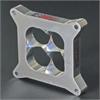
SS4150-2: 2" Super Sucker for 4150 carbs
Use on all single plane 4150 intake manifolds
Slightly more power than SS4150-1 throughout rpm range on 500cid+ engines running WOT at approx 5400rpm's or more
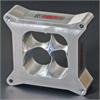
SS4500-4150-2: 2" Super Sucker for 4500 carbs to be mounted on 4150 intake manifolds
Use on single plane 4150 intake manifolds
Many of today's modern large cid small blocks and big blocks using 4150 intake manifolds are being limited by carburetor size, however to run a 4500 carburetor most where forced to run a possibly 'too large plenum + runner' 4500 style intake manifold. Using a dominator carb on the modern high flow 4150 intakes where getting good results even with a generic 2" open adaptor, therefore HVH went to the table, spent a ton of time, and came up with this piece of artwork. Sweet ! Just what the doctor ordered.
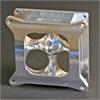
SS4500- 1: 1" Super Sucker for 4500 carbs
Use on single plane 4500 intake manifolds
Use where there is not enough room for a 2" 4500 Super Sucker. Why? An engine that uses a dominator carburetor and an intake manifold designed for a dominator carburetor is very large in cid and/or runs at very high rpm. These engines will like the 1" Super Sucker but will benefit that much more with a 2" SS.
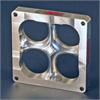
SS4500-2 : 2" Super Sucker for 4500 carbs
Use on single plane 4500 intake manifolds
Because your big dominator carb'd / big dominator intake'd fire breathing engine wants as much air / fuel it can get.
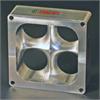
Above spacers are the most commonly used, thus why I mentioned what they are for and what they do. There are many more specific carb spacers available - cloverleaf dominator, 2.1" bore dominator, 4150 on split plenum dual plane, 4150 on dual plane with window in divider, many 2bbl spacers for different intakes, and etc.
Benefits:
Carburetor spacers can help many engine combinations pick up solid power increases from more airflow into each cylinder. Airflow not always being everything, spacers can create a stronger and more accurate air stream coming thru the carburetor, which in essence, gives you better carburetion and thus more power also. Other benefits can include better throttle response, tighter cylinder to cylinder exhaust temperature differences, and more consistent carburetion.
================================================== ======
Materials :
Cast aluminum, plate aluminum - ie: billet, plastics - few different types, and phenolic. Phenolic looks like 'wood' and thus is commonly referred to as either 'phenolic' or 'wood' or 'phenolic wood.' It is actually a resin and laminate combination.
What material is better ?
For marine performance engines I like to use either billet aluminum and/or phenolic.
Billet aluminum is by far the strongest carb spacer material available. It will not crack, warp, or melt with any engine temperature. You could probably kick it down your asphalt driveway , by mistake of course, with it still being okay other than a few nicks and such.
Phenolic is also a fantastic carb spacer material. It's not as rugged as billet aluminum of course, but will withstand high heat extremely well. It can be warped or cracked with over tightening the carb when bolted down, but you'd have to really try hard to do this.
Phenolic's main advantage is primarily when an engine's intake manifold gets hot enough to effect the fuel temperature in the carb's fuel bowls. Phenolic is the best heat rejecting carb spacer material used. It is a good choice to use especially hen dealing with an intake manifold that has one or both of the following :
Non air gap style intake. Oil temperature can greatly influence the actual temperature of the carburetor since the intake manifold's base is exposed to hot engine oil + air temp from the lifter galley. The hotter the oil + air, the hotter the intake and carburetor.
Exhaust gas crossover from the cylinder heads thru the intake manifold. Many factory or factory replacement intake manifolds have this. Edelbrock Performer and Weiand Action Plus intakes are good examples. This is used to get intake manifold hot enough, quick enough so that idle/low speed running is as smooth as possible. This exhaust crossover, as you can imagine, can make the intake and carburetor hot enough that performance suffers.
================================================== =======
Generic Carburetor Spacer Design:
This is what we typically see in catalogs and magazines. The 'tuning tools of yester- year', as I call them. I will talk about the function of these as they give us great insight on what basic carb spacers can do.
Four hole: Generally, a four hole spacer creates longer throttle bores for the carburetor. This can help straighten the air coming thru the carb and thus helping the carburetor to function more correctly. Drawbacks is that this longer 'throttle bore' creates restriction. At first glance it wouldn't appear so, but when you test up to a 2" thick 4 hole spacer, it really becomes apparent. In my experiences, I have never seen a benefit to using a 2" thick 4 hole spacer.
Four hole spacers can help when the carb is having a tough time metering fuel. This is more typical at lower engine rpm when one or more of the following is used : large carburetor throttle bores, large plenum/runner intake manifold, large overlap camshaft, and etc.
Open: An open spacer creates more intake plenum volume. Added plenum volume can help by slowing down the air/fuel charge to give it more of a chance to make the turn into the intake manifold runners. It also can help, in the same regard, by giving more distance to the air/fuel charge which can make a longer, more gradual turn.
Open spacers do not help the carburetor in any way. They are strictly a plenum volume size adder. In fact, added plenum can hurt the carburetor in low engine rpm conditions. As stated above, added plenum will reduce air speed, and furthermore this also means reduced airspeed thru the carb's throttle bores and thus boosters.
This is why open spacers are generically termed 'better for high engine rpm.' Rightfully so.
Result: Since both the open and 4 hole spacers have some tendencies but no clear answers to how they'd work on a certain engine build, one would have to take one 4 hole and a 1" and 2" open spacer to the track and/or dyno and try different combos to see what the engine +carburetor really responded to, if they did. In generic form, this is why we call them 'tuning tools.'
================================================== ====
Specific Carburetor Spacer Design:
Enter modern performance engine building. Many years of trying different shaping + designs with more specific engine builds along with a culmination of dyno tests and real world use has led to many discoveries and an easier answer to "what should I expect."
There are now specific spacers made for different carburetor, intake manifold, and engine build combinations.
I offer approximately 30 or more different carburetor spacers. A few generic, but most are specific. That's a far cry than just your typical 4 offered from non-spacer companies. Sound confusing ? Not really. It actually makes it easier for the end user. Most of the time I can pick 'the one' spacer that will be the best for them, and for a few small % of people, I can narrow it down to two. Some applications will not make more power with a spacer, I'm not afraid to say. Remember, typically you'd have to show up at the track or dyno with a bag full of open and 4 hole spacers, and yet, many of those times a more specific spacer would still make more power and better drivability then what you'd typically end up with.
Blended Carburetor Spacer Designs:
Although some retailers and manufacturers don't say this, these are specific carburetor spacers also. 'Blending' add direction to the air charge, therefore one design should be made and stated for a certain carb / intake configuration since direction effects a lot of what happens coming thru the carburetor and how it enters the intake manifold.
Blended spacers use aerodynamics behind the carburetor. As we all know now, with cars, boats, airplanes, etc that the rear of an object is just as important as the front of the same object when air is passing over, under, or thru it. This is exactly how and why a properly designed spacer can really help an engine reach peak performance.
So, if a spacer is blended in such a way that it will promote more airflow thru the carburetor and into the cylinders, while helping the carburetor perform it's intended function better, and help direct the air/fuel charge in a more efficient manner to the intake manifolds plenum and runners, we have just made the entire engine itself more efficient, powerful, and consistent.
Time for 'Super Sucker' Talk:
These are blended/and or specific. One design does not work on all intake/manifold/engine configurations because they are designed for specific combinations. There are approximately 15 different configurations available. That's much more than the 2-4 of most other spacer makers.
First worthy mention here is that I am not HVH - the company that designs and manufacturers the "Super Sucker's" - and I do not work for them.Our relationship is that years back they had purchased one of my 2bbl FI spacers and liked it enough that they wanted to be licensed to make and sell them. The relationship instantly grew much stronger when I received some of their carb spacers to take a look at and test. I was excited to see that they had designed their spacers much like I had been also doing for years. Mine where slightly different, of course, and blended by hand out of phenolic only do to ease of hand grinding. Their designs where making a tad more power than mine during my testing, so the choice became obvious - sell and recommend theirs. I do still make many restricted rules racing spacers by hand grinding phenolic, but I am not ready just yet to give those to other companies yet.
Okay, enough about that, let's check out a few of the most commonly used HVH's (High Velocity Heads) "Super Sucker" carburetor spacers.
SS4150-1: 1" Super Sucker for 4150 carbs
Use on all single plane 4150 intake manifolds
Power range - low rpm thru WOT throttle

SS4150-2: 2" Super Sucker for 4150 carbs
Use on all single plane 4150 intake manifolds
Slightly more power than SS4150-1 throughout rpm range on 500cid+ engines running WOT at approx 5400rpm's or more

SS4500-4150-2: 2" Super Sucker for 4500 carbs to be mounted on 4150 intake manifolds
Use on single plane 4150 intake manifolds
Many of today's modern large cid small blocks and big blocks using 4150 intake manifolds are being limited by carburetor size, however to run a 4500 carburetor most where forced to run a possibly 'too large plenum + runner' 4500 style intake manifold. Using a dominator carb on the modern high flow 4150 intakes where getting good results even with a generic 2" open adaptor, therefore HVH went to the table, spent a ton of time, and came up with this piece of artwork. Sweet ! Just what the doctor ordered.

SS4500- 1: 1" Super Sucker for 4500 carbs
Use on single plane 4500 intake manifolds
Use where there is not enough room for a 2" 4500 Super Sucker. Why? An engine that uses a dominator carburetor and an intake manifold designed for a dominator carburetor is very large in cid and/or runs at very high rpm. These engines will like the 1" Super Sucker but will benefit that much more with a 2" SS.

SS4500-2 : 2" Super Sucker for 4500 carbs
Use on single plane 4500 intake manifolds
Because your big dominator carb'd / big dominator intake'd fire breathing engine wants as much air / fuel it can get.

Above spacers are the most commonly used, thus why I mentioned what they are for and what they do. There are many more specific carb spacers available - cloverleaf dominator, 2.1" bore dominator, 4150 on split plenum dual plane, 4150 on dual plane with window in divider, many 2bbl spacers for different intakes, and etc.
Last edited by SB; 05-10-2014 at 08:37 PM.
#10
Registered
With a cam that radical on a 509 I would not fool with it unless you completely redyno. It also could be that you spend 2,000 on dyno time and onbly gain 5 hp or none at all. If it was my engine - don't phuk with it. 684 out of 509 is DAM good....




